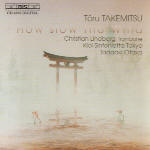Toru Takemitsu never could get his mind around fast music; just about everything he writes is a slow wash of sound with plenty of tidal ebb and flow. His music (as the names of his pieces clearly suggest) is deeply involved with nature–illustrated by titles such as Tree Line, How Slow the Wind, and Rain Coming. He doesn’t shy away from awe; it seems the entirety of his oeuvre is a paean to the beauty of earthly things. To interject a personal note, I once saw Takemitsu give a presentation about his process. He said, “If I get a commission for a 20-minute piece, I take a 20-minute walk. When I see a tree, I write tree music; when I see a rock, I write rock music; when I see a tree in front of a rock, I combine the two. Basically I enjoy walking.” Takemitsu’s innocence and unpretentiousness are what make his music effective.
Tadaaki Otaka and the Kioi Sinfonietta really understand the power that lurks behind the notes. They don’t play painfully slow or self-indulgently, and they allow the music to breathe. The gem-like quality of Takemitsu’s virtuoso orchestration sounds clearly and with the intended simple beauty. In Archipelago S the delicate textures (made up of interweaving, contrapuntal lines) all-but glisten–it’s only too bad that a recording couldn’t capture this piece’s spatial elements, and that Christian Lindberg’s powerful trombone wasn’t more effectively exploited.
The Requiem is a multi-hued exploration of string timbres, moving and full of color; How Slow the Wind is lighter, more spry, freely indulging in Debussy-like orchestrational washes with beautiful results. These pieces are about being in the moment, so an entire disc-full tends to be a little hard to take–they blend together, which does each of them a disservice. But if you’re looking for slow, dreamy music in which it’s possible (and desirable) to get lost, this well played, carefully recorded release is for you.
































